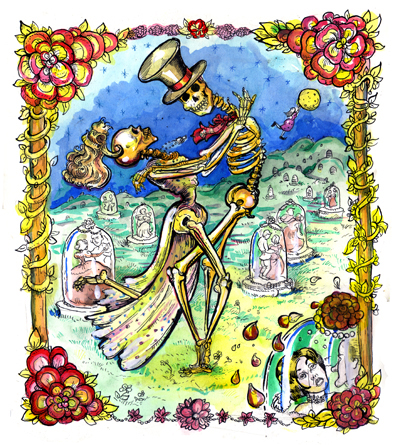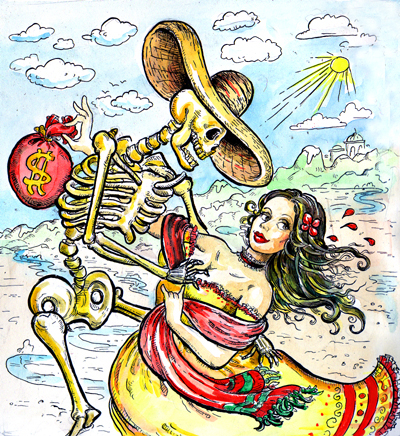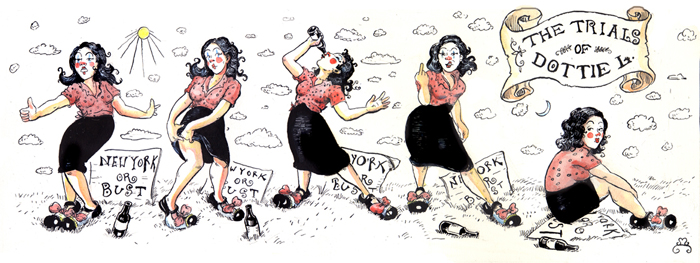 |
| Molly Crabapple photo by http://www.ideamensch.com |
Periods in history that have embraced burlesque have been times of political upheaval. These are accompanied and/or caused by socio-economic inequalities. Examples of this are the heyday of the Moulin Rouge, the staid façade of the Victorian Era, the Edwardian Gibson Girl, and the Follies that foiled the grim realities of the 30s, and the world today. Not surprisingly, Neo-Burlesque is a popular part of New York nightlife. Events take place almost daily, sometimes drawing crowds of thousands. Shows include the expected strip tease but also acrobats, magicians, comedians and circus performers, as it did in its' early days when a launching pad for Vaudeville, with focus on individuality rather than raunchiness.
The description defies the impression many of us have of burlesque but Crabapple, describes the difference: "When my mother was nineteen she worked in the Catskills and saw burlesque shows that toured there. She said it was horrible, aging strippers shaking around, bored out of their minds.
"Now it's cool. It's like the saying, don't expect to like your children expect to like your grandchildren. People in general don't think their parents are cool. For our generation, there's no association with burlesque at all except one with a glamorous, decadent time in the past. It appeals very much to women as well as men. For men, sex is not that complex, but burlesque combines a very female feeling of sexiness.
"I started reading books about Paris in the mid to late 1800s. I got really inspired by them. It got my mind churning. Why not have that? I looked for something like it but found nothing. So I just did it. You can create the New York you want each day. In my dream of New York, artists aren't isolated in studios or ivory towers. I want an art world that's fun and talent-loving and decadent, a 21st century Montmarte."

"We comb New York to find the most beautiful burlesque dancers, the most bizarre circus freaks, and the most rippling hunks of man. Then, on the second Saturday of every month, we let you draw them for three hours…did we mention you can buy coffee? Expertly mixed booze?" Thus says Molly Crabapple. (Cabaret Life Drawing)
Why? Well, as an artists model she had romantic expectations but found the reality dull, de-humanizing and not particularly well-paying. So, along with friend A.V. Phibes, she created, "a place where models could make a fair wage and express their amazing personalities, while sketchers could partake of that pseudo-bohemian atmosphere so many of us went to art school for."
Crabapple, recently off a tour promoting her new, "Dr. Sketchy's Rainy Day Activity Book," produces a seemingly endless flow of funky ideas. For example, a show at MF Gallery featured interpretations of what the name really stands for, and an erotic show in Philadelphia, included several pieces that objectify men. A recent Dr. Sketchys' show at the Edinburgh Fringe produced not only art but sold out houses and 5 star reviews. Upcoming…another Dr. Sketchys' anti-art show. There are even rumors of a webcomic in progress.
A little like Lautrec, she is immersed in a Fin de Seicle scene and renders it. "Lautrec didn't do the classes." she laughingly reminds me when I asked her if she saw parallels between his work and her own. And Lautrec never did a 6"7 tableaux of demons re-enacting the 7 deadly sins like Molly did. "It was very Bosch", she said, "but I like doing smaller work as a general rule, it's more spontaneous."
Her renderings of the scene are sensual yet often sarcastic and a little sinister. Though quite different in execution, her work is a bit Goya-like, subjects caught unawares in a private moment, from the beautiful to the grotesque. The moments she captures often have cynical, wistful or slightly foreboding tones. "I want my work to show the aching backs, the fake smiles, the low wages, the greasepaint and the sweat of performance as well as the tassels and sequins. We live," she said, "especially in NY, in a fame and celebrity obsessed culture, and people create these elaborate personas, I think that's interesting. I don't condemn at all – we live in a time of elaborate promotion. I find it fascinating. I try to expose what's underneath it."
These and other subjects, beautiful women growing old, useless rich and drudging poor, making a living appealing to really unappealing men are reminiscent of the work of artists from the mid 1800s-early 1900s. However, like burlesque itself, her work also contains a heavy dash of humor. "Where other people might denounce," she says of her sexy sideshow of subjects, "I poke fun."
Its artifice itself that fascinates her most, she is, in a way, its knight in spangled armor, describing it as the very basis of Western art. The transformation of a blank piece of paper "through trickery" becoming something entirely different. The arts, performing and fine art in particular are, for Crabapple, a sort of black magic.

"I love how, onstage, you create an entirely different self in the same way you create a canvas." She said in a recent interview. "I love the power of being what you're not. I love how a good photograph doesn't so much as capture a moment as invent one a moment far more poignant and symbolic than the one when the picture was taken."
And what is she turning her magic wand, (or pen, rather), to now?
"Appalachian folk murder ballads," she says, "I'm turning the killers and victims into religious icons – with the occasional sarcastic touch; and, of course, a series of portraits of New York's burlesque and sideshow artists." As she's particularly struck by the difference between the ways the artists look in and out of costume, this series is bound to be presented with a unique twist; she describes herself as motivated to draw both.
"I love how, onstage, you create an entirely different self in the same way you create a canvas." She said in a recent interview. "I love the power of being what you're not. I love how a good photograph doesn't so much as capture a moment as invent one a moment far more poignant and symbolic than the one when the picture was taken."
"I don't think of my subjects as extreme because, for me, it's the way life is. In the East Village performance scene everyone is doing things like that, the idea of doing it myself seemed normal to me." of course I can do this or that – very loner no one to squash and say no basically made my life school to live out whatever strange weird. For example, her sideshow acts. "A friend taught me" she said, "I haven't done it in a while." This from a girl who can eat fire, drive nails up her nose, walk on glass and chew light bulbs. "But I don't so much do the light bulbs" she said "it's hard on the enamel of your teeth."
What led up to all of this? A real life Alice, she has made exotic locales in the world and underworld her Wonderland and taken excellent notes, visual and in the form of essays, along the way. As a child, Molly Crabapple read a lot and didn't really see the difference, she says, between books and real life. Fantastic tales of Arabian nights seemed alive enough to her to merit trips across both Europe and the Middle East.
While filing five notebooks with travel sketches she visited four continents, snuck into mosques, been detained in jails, drew for bread and lived in attics. "When I was 18 all I wanted to do was run off to the Middle East. I studied Arabic and Turkish, spent my off hours in Barnes and Noble reading Lonely Planet Pakistan, and could talk your ear off about Orhan Pamuk." She ran off with $300 and traveled the globe, inspired by Anais Nin. I guess I've mellowed a bit." She even lived in bookstore (Shakespeare and Co.) in Paris (sleeping on the floor in exchange for working the cash register), home to wayfaring artists for over 50 years. She describes it as "a gorgeously bohemian place with with thumb sized roaches, squat toilets and no working showers."

So, done with world travel and moving forward from pen and ink to color, what can we expect from Crabapple next? She's' thinking 19th century American poster art. "You know, poster art before they got the hang of it. It's creepy and stiff and overly detailed with lots of windy text. All the children look like midgets." She expresses a love of their "ridiculous literalism and hallucinatory detail." And she's got some new ideas for her shows too, matchbooks, cigar boxes, ticket stubs reminiscent of the ephemera of bygone eras. "It reminds me of a time when art was part of everyday life."
And no doubt it will be reflective of an extraordinary everyday life. For Crabapple has long blurred the distinction between artist and subject, between creator and muse.
Published in 'Fine Art Magazine' and at GratefulWeb.net
No comments:
Post a Comment